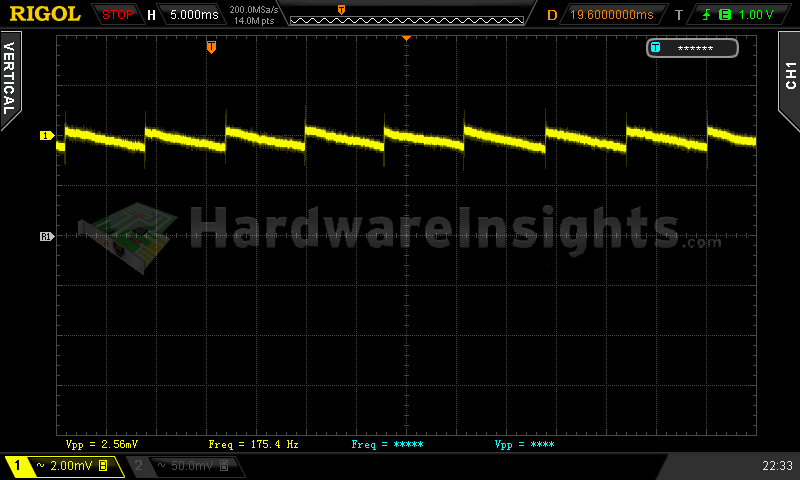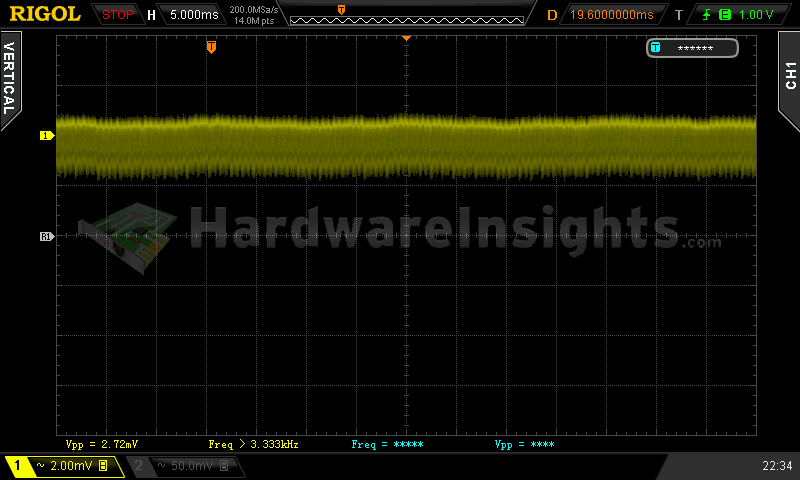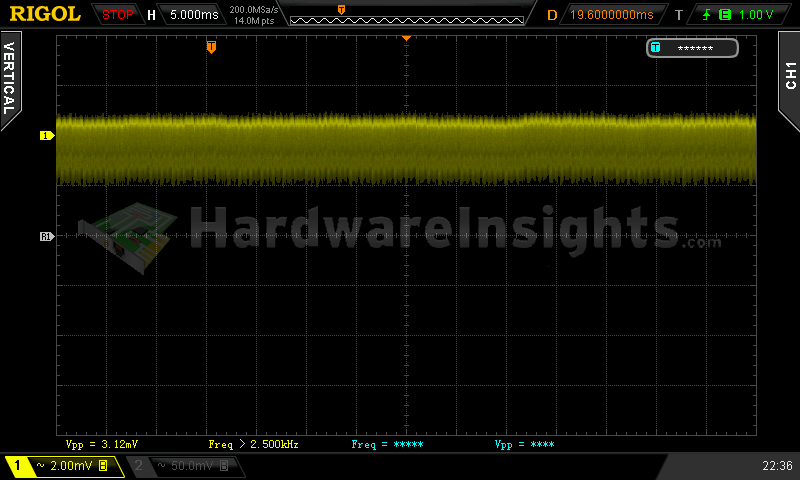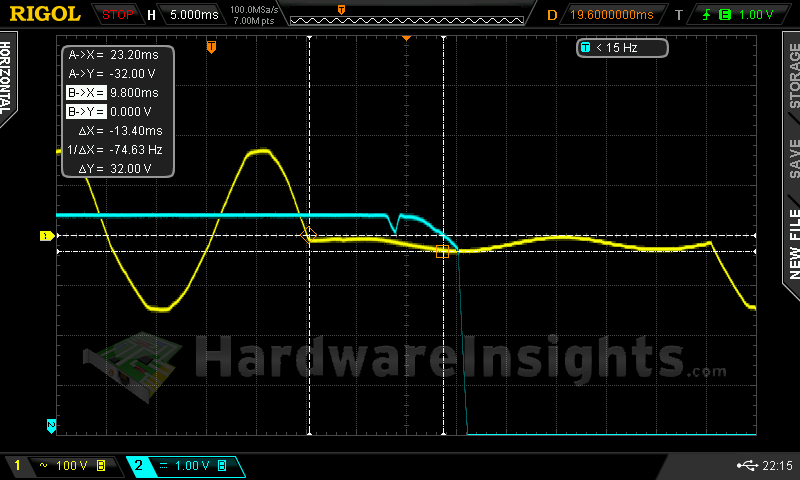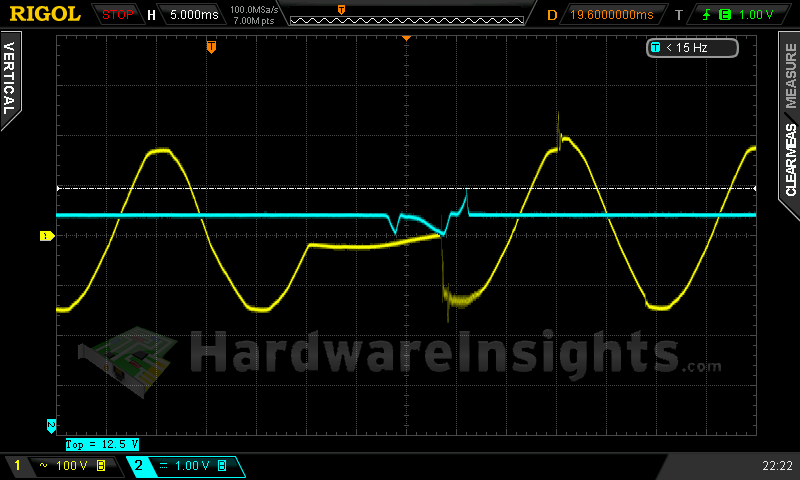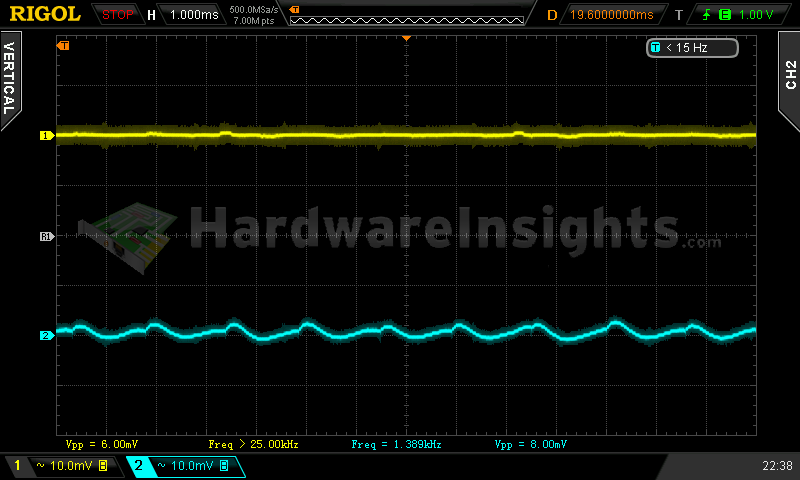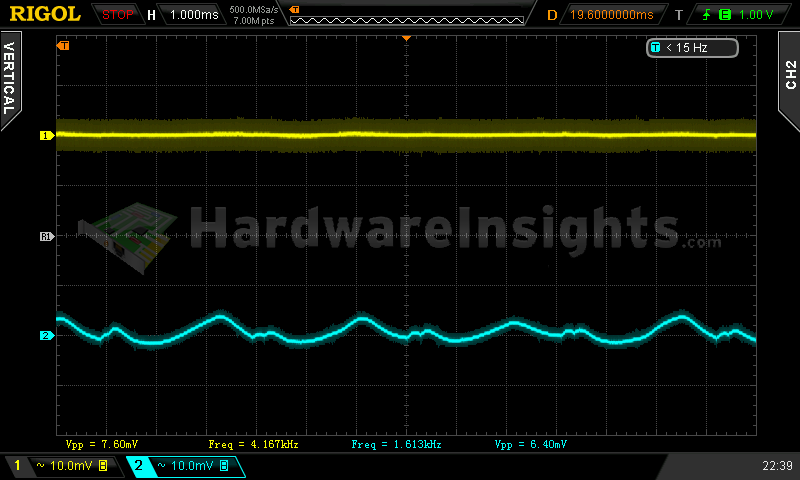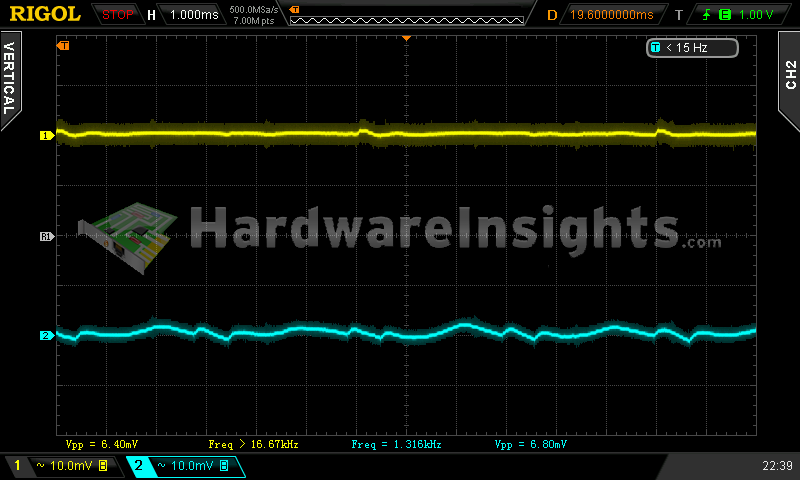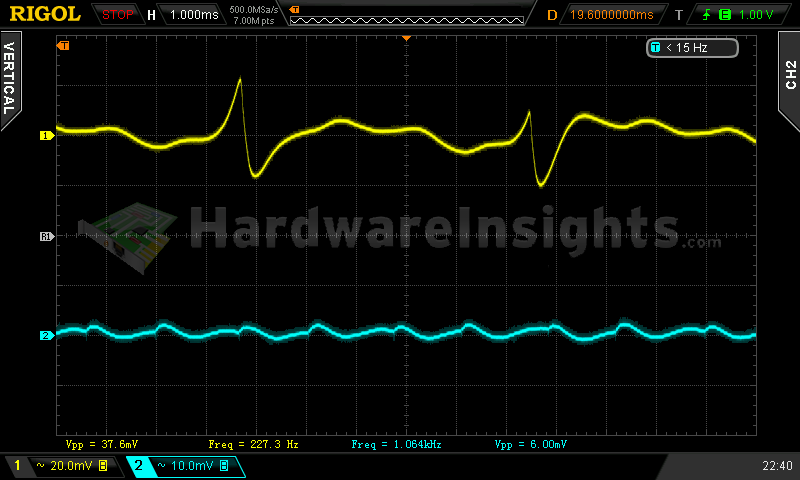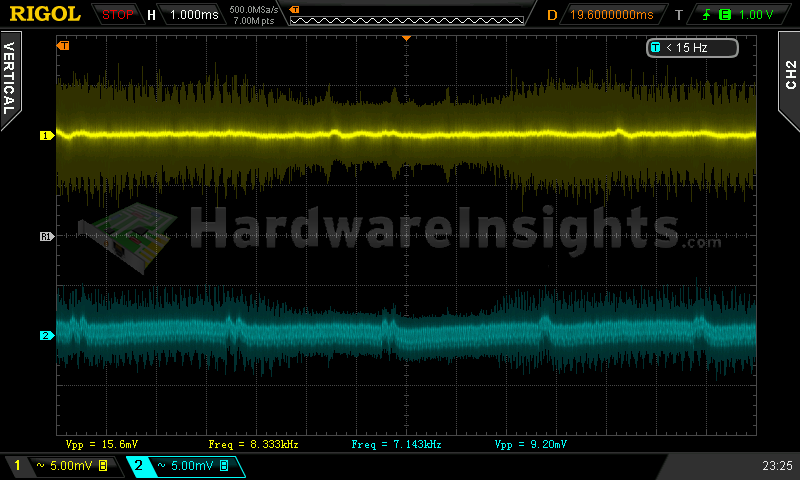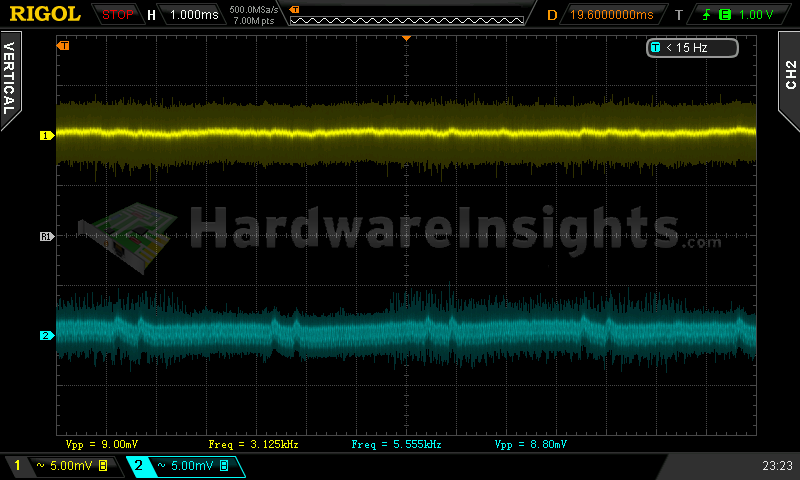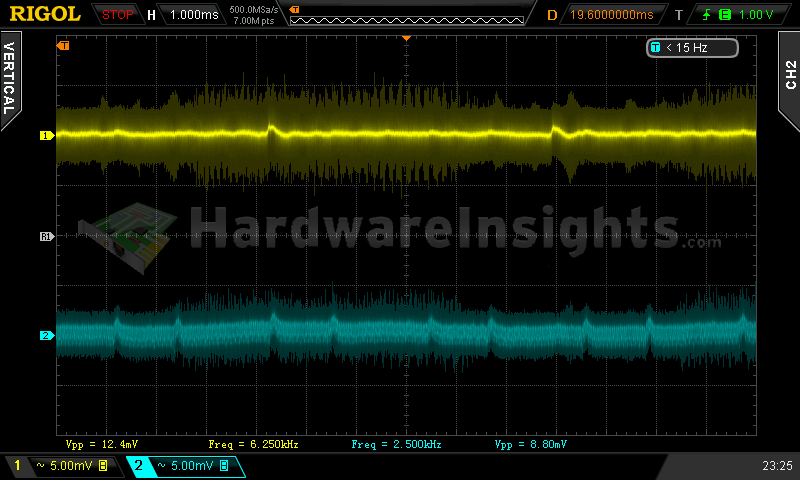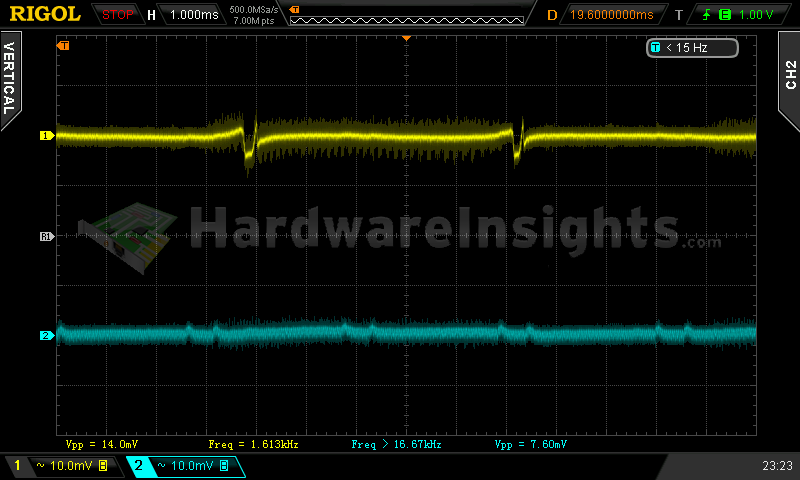Contents
- 1Introduction
- 1.1Packaging and accessories
- 2Connectors & cabling
- 2.1Casing & cooling
- 3Input filtering
- 4Primary side
- 4.1+5 V stand-by rail
- 5Secondary side
- 5.1Build quality
- 6Load testing
- 6.1Loading +5 V SB
- 6.2Voltage hold-up time
- 6.3Combined loading
- 6.4Combined loading ripple
- 6.5Crossloading, overloading
- 6.6Crossloading, overloading ripple
- 7Conclusion and evaluation
- 7.1Thanks
- 7.2Discussion
Load testing
Loading +5 V SB
As always, all load testing is done in accordance with testing methodology. We see cheap Sanken Electric PWM again, this time it already starts with low voltage unlike the one in Silverstone Strider Gold S so under load, the voltages goes down the tube. Despite that the efficiency is quite nice, around 78 % but voltage slightly over 4.80 V, that is not so impressive. So it will not get any extra points. Ripple is OK.
| Output (W) | Load (A) | Voltage (V)/ ripple (mV) | Input (W) | Efficiency/power factor |
| 0 | 0 | 4.91/2.56 | 0.5 | —/0.02 |
| 11.37 | 2.35 | 4.84/2.72 | 14.5 | 78.4 %/0.33 |
| 15.65 | 3.25 | 4.81/3.12 | 20.0 | 78.2 %/0.49 |
+5 V SB ripple (left to right): 0 A; 2.35 A; 3.25 A
Voltage hold-up time
The hold-up time of the +12 V rail on the scope image is already very good, 23.2 ms. Being first, pilot hold-up time measurement, I have been battling with it and made one mistake – the second channel level is moved to -11.6 V actually, not -11.4 V (as 11.4 V is ATX minimum). So when the voltage briefly touches zero, it is not actually 11.4 but 11.6 V so it is still within ATX tolerance. So measuring the time optically now, it is 25 ms (give or take) to ATX minimum. As you can see, the unit turned off briefly for that time when feedback sensed it is 11.4 V.
I have also tried interrupting the power for 23.2 ms to see what happenes. A 12.5V transient spike occured .
Combined loading
Combined loading was mostly flawless. The SanKen strikes again with 4.89 V under full load, but the −12 V rail started high on the other hand, with −11.17 V. It seems at low combined load with high load on the rail the transformer winding does not provide enough power for the regulator to keep −12 V. In this case as it has dropout voltage of 1.4 V the supplies voltage was only −12.57 V. Enhance should have added one more winding on the transformer and used 35V capacitor for regulator input as the no-load voltage may increase than, but the regulator will provide clean −12 V on the output. On the other hand this L7912CT precision is not wonderful either, the voltage was already dropping under −12 V at full combined load.
| Output power | Load/ voltage +5 V SB | Load/ voltage +3.3 V | Load/ voltage +5 V | Load/ voltage +12 V | Load/ voltage −12 V | Input power | Efficiency/power factor | Temperature intake/ outtake |
| 5.0 %/ 27.48 W | 0 A/ 5.00 V | 0 A/ 3.32 V | 0.294 A/ 5.01 V | 1.883 A/ 12.07 V | 0.293 A/ −11.17 V | 33.0 W | 83.3 %/ 0.60 | 27 °C/ 29 °C |
| 20 %/ 111.02 W | 0.490 A/ 4.98 V | 1.485 A/ 3.31 V | 1.481 A/ 4.99 V | 7.70 A/ 12.05 V | 0.296 A/ −11.76 V | 120.0 W | 92.1 %/ 0.90 | 28 °C/ 29 °C |
| 40 %/ 222.29 W | 0.97 A/ 4.96 V | 4.12 A/ 3.30 V | 3.35 A/ 4.98 V | 15.26 A/ 12.03 V | 0.302 A/ −12.06 V | 237.5 W | 93.6 %/ 0.96 | 28°C/ 30 °C |
| 60 %/ 328.4 W | 1.43 A/ 4.93 V | 6.89 A/ 3.28 V | 4.82 A/ 4.96 V | 22.6 A/ 12.00 V | 0.30 A/ −12.08 V | 355.0 W | 92.5 %/ 0.97 | 28 °C/ 31 °C |
|
80 %/ 439.48 W |
1.89 A/ 4.92 V | 8.39 A/ 3.27 V | 7.77 A/ 4.95 V | 30.1 A/ 11.98 V | 0.305 A/ −12.11 V | 481.0 W | 91.4 %/ 0.98 | 28 °C/ 33 °C |
| 100 %/ 549.75 W | 2.33 A/ 4.89 V | 11.15 A/ 3.25 V | 10.24 A/ 4.94 V | 37.5 A/ 11.94 V | 0.310 A/ −12.14 V | 614.5 W | 89.5 %/ 0.98 | 29 °C/ 36 °C |
The efficiency is nice with over 93 % maximum, it dropped somewhat more by the end, under 90 %. On the other hand I drew more combined power from +3.3 and +5 V than usual which drops the efficiency. Temperatures were OK from the beginning, after 80 % load the fan was spinning noticeably faster (both optically and judging from its underpressure over the grille) yet temperatures were still rising. Once again this is a proof that bigger heatsink for the rectification transistors should have been used so the unit can be even quieter than the first revision. It is better but there is still room for improvement. I think optimal power for this unit is around 400 watt but it also depends on the overall cooling in your case.
Combined loading ripple
I quite like what I see here. The ripple mostly stayed within 15 mV, only exception was when the −12 V regulator was not regulating at all since it had insufficient voltage on its own input, than it went as high as 40 mV. But that is also because I load the rail with fan, you can see the waveform. It is still less than 40 % of ATX specification and only on the −12 V rail where the requirements are not so tough so the unit is going to gain points here, many points. I think these are really good results.
| Output % | Ripple +5 V SB | Ripple +3.3 V | Ripple +5 V | Ripple +12 V | Ripple −12 V |
| 5.0 | 6.00 mV | 7.60 mV | 6.40 mV | 8.00 mV | 37.6 mV |
| 20 | 10.80 mV | 5.20 mV | 10.40 mV | 8.00 mV | 40.2 mV |
| 40 | 10.40 mV | 10.8 mV | 8.80 mV | 7.20 mV | 9.2 mV |
| 60 | 14.4 mV | 9.60 mV | 14.0 mV | 7.20 mV | 9.6 mV |
| 80 | 16.4 mV | 9.60 mV | 15.2 mV | 10.40 mV | 12.0 mV |
| 100 | 15.6 mV | 9.00 mV | 12.40 mV | 9.20 mV | 14.0 mV |
Ripple 5.1% load (left to right): +5 V SB; +3.3 V; +5 V; −12 V. The second channel is connected to +12 V.
Ripple 100% load (left to right): +5 V SB; +3.3 V; +5 V; −12 V. The second channel is connected to +12 V.
Crossloading, overloading
Crossloading went quite well, considering this is +12V unit with DC-DC modules, I did not expect anything else. Voltage regulation was somewhat tighter, however, the stand-by supply still stayed quite low, however, all rails squeezed into 2 % regulation. I also like its high efficiency even with +3.3 and +5 V crossload. I think that while taking 20 A from +3.3 V, no other supply managed to achieve 87% efficiency, I would say it is worth three extra points! OCP limit was not reached on any rail and all of them handled the applied overloading without any problems.
| Output power | Load/ voltage +5 V SB | Load/ voltage +3.3 V | Load/ voltage +5 V | Load/ voltage +12 V | Load/ voltage −12 V | Input power | Efficiency/power factor | Temperature intake/ outtake |
| 100 %/ 555.09 W | 0.479 A/ 4.93 V | 1.438 A/ 3.26 V | 1.419 A/ 4.94 V | 45.0 A/ 11.94 V | 0.307 A/ −12.12 V | 617.0 W | 90.0 %/ 0.98 | 30 °C/ 39 °C |
| 24 %/ 133.41 W | 0.495 A/ 5.04 V | 1.475 A/ 3.30 V | 19.51 A/ 4.99 V | 1.916 A/ 12.05 V | 0.311 A/ −12.00 V | 147.0 W | 89.5 %/ 0.93 | 28 °C/ 34 °C |
| 19 %/ 101.82 W | 0.479 A/ 4.97 V | 20.01 A/ 3.30 V | 1.470 A/ 4.98 V | 1.874 A/ 12.05 V | 0.297 A/ −11.78 V | 117.0 W | 87.0 %/ 0.90 | 27 °C/ 33 °C |
| 130 %/ 714.13 W | 3.18 A/ 4.84 V | 10.98 A/ 3.23 V | 11.92 A/ 4.91 V | 50.5 A/ 11.90 V | 0.310 A/ −12.19 V | 815.5 W | 87.6 %/ 0.99 | 30 °C/ 41 °C |
The OTP is completely different question. The Sweater contest was a complete fail for me as the unit did not even bother with that (the sweater has many holes through which it can suck air). I tried adding some insulation but it was futile. I think I will only give the unit pass and no extra points as it is somewhat easier to achieve that while having a fan, unlike the Seasonic Platinum Fanless or Enermax Digifanless. Only after I stuck the fan the unit overheated, quite fast actually (30 seconds or so) because of the small secondary heatsink. Combined overloading finally turned the unit off around 130 % of nominal power. After 710 watts the unit started oscillating heavily, it was like if it was turning off and on for a fraction of each second. A short moment later it turned off. Seems that overheating was the cause once again (as back in 2013 if I recall correctly), otherwise it will continue to supply power who knows to what amount ☺
Crossloading, overloading ripple
The ripple climbed a bit on the −12 V rail, otherwise it was quite good.
| Output % | Ripple +5 V SB | Ripple +3.3 V | Ripple +5 V | Ripple +12 V | Ripple −12 V |
| 100 | 15.0 mV | 13.4 mV | 13.60 mV | 9.60 mV | 10.8 mV |
| 24 | 8.20 mV | 6.60 mV | 8.40 mV | 10.4 mV | 41.6 mV |
| 19 | 11.2 mV | 7.00 mV | 8.20 mV | 11.0 mV | 46.0 mV |
| 130 | — | — | 18.4 mV | 14.2 mV | — |
